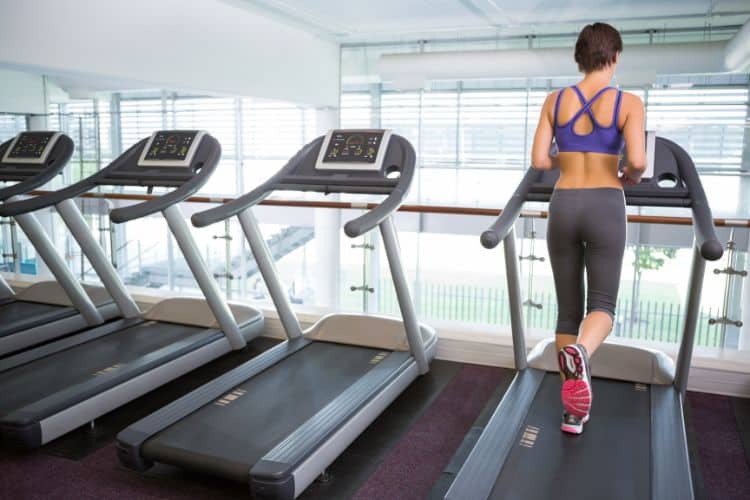Sign up for workout ideas, training advice, reviews of the latest gear and more.





If you’re short on time but still want a powerful cardio session that boosts calorie burn, improves endurance, and helps you feel energized for the rest of your day, a 20-minute treadmill workout is one of the most effective fitness strategies you can add to your routine. Treadmill workouts have come a long way from traditional steady-state jogging—in just 20 minutes, you can target fat loss, increase cardiovascular strength, and build lower-body power using structured intervals and intensity shifts.
This guide breaks down how effective a 20-minute treadmill workout really is, the benefits, the best warm-up, and multiple 20-minute routines you can choose from based on your fitness level. Whether you’re a beginner aiming to increase your stamina or a seasoned runner looking for a quick fat-burning session, this workout offers something for everyone.
Twenty minutes may sound short, but interval-based treadmill workouts increase intensity in a way that revs up your metabolism, elevates your heart rate, and trains your body to work harder in a condensed timeframe. This aligns perfectly with what research shows about short-duration, high-intensity exercise being superior for fat burning and cardiovascular improvement.
One of the biggest advantages of a 20-minute session is the activation of EPOC (Excess Post-Exercise Oxygen Consumption)—your body’s “afterburn effect,” where it continues to burn calories even after the workout ends. Treadmill intervals are excellent at stimulating EPOC due to the quick bursts of speed and incline.
A well-structured treadmill session engages the glutes, hamstrings, quads, and calves while improving lung capacity and stamina. Incline sections also mimic outdoor hill running to help build power and prevent plateaus.
Whether you squeeze it in during your lunch break or use it as an energizing morning routine, 20 minutes is easy to commit to. It’s fast, effective, and can be tailored to your fitness level.
Interval treadmill workouts increase calorie burn because your heart rate fluctuates between high-intensity bursts and recovery periods.
Just 20 minutes of cardio can significantly improve cardiovascular strength, making your body more efficient at pumping blood and delivering oxygen through your muscles.
Walking or running on an incline activates your hamstrings, calves, and glutes, making your lower body stronger and more toned.
Short workouts help you stay accountable—it’s much easier to follow through when the commitment feels manageable.
If you’re just starting, you can stick to incline walking, speed walking, or slower intervals to still get an excellent cardio session without pounding your joints.
Before diving into any treadmill workout, start with a gentle warm-up to prepare your muscles and increase circulation.
Warm-up:
This primes your body for the faster intervals, reduces injury risk, and helps you perform better.
Below are four variations of the 20-minute treadmill workout—choose one depending on your goal, fitness level, and energy for the day.
Perfect for those new to cardio or returning to exercise after a break. This routine keeps intensity manageable while still boosting your calorie burn and improving endurance.
Minutes 0–3 – Warm-Up
Walk 2.5–3.5 mph
3–5 Minutes
Increase to a brisk walk at 3.5–4.0 mph
5–7 Minutes
Light jog at 4.5–5.0 mph
7–9 Minutes
Recovery walk at 3.2–3.5 mph
9–11 Minutes
Jog at 4.5–5.0 mph
Minutes 11–13
Incline walk at 3.5 mph at 4% incline
13–15 Minutes
Jog at 4.8–5.2 mph
15–17 Minutes
Walk at 3.2 mph
17–20 Minutes – Cool Down
Walk at 2.5–3.0 mph
This routine includes short jogging intervals and varied incline to keep your heart rate elevated without overwhelming your body. It’s an ideal starting point for beginners.
This high-intensity interval routine maximizes calorie burn and promotes fast fat loss. Perfect if you want a sweaty, powerful workout in minimal time.
0–3 Minutes – Warm-Up
Walk 3.0–3.5 mph, slight incline 1%
3–4 Minutes – Sprint
Speed 7.0–8.5 mph
4–5 Minutes – Recovery
Walk 3.0 mph
5–6 Minutes – Sprint
Speed 7.0–8.5 mph
6–7 Minutes – Recovery
Walk 3.0 mph
7–8 Minutes – Sprint
Speed 7.2–8.8 mph
8–9 Minutes – Recovery
Walk 3.2 mph
9–10 Minutes – Sprint
Speed 7.0–8.5 mph
10–11 Minutes – Recovery
Walk 3.0 mph
11–12 Minutes – Sprint
Speed 7.5–9.0 mph
12–13 Minutes – Recovery
Walk 3.2 mph
13–15 Minutes – Jog/Run
Speed 5.0–6.0 mph
15–18 Minutes – Incline Walk
3.5 mph at 6–8% incline
18–20 Minutes – Cool Down
Walk 2.8–3.0 mph
The combination of sprints, incline, and moderate-paced jogging stimulates maximum calorie burn while challenging multiple energy systems at once.
This variation is excellent for women who don’t want high-impact running or sprinting but still want intense calorie burn and strong lower-body activation.
0–3 Minutes – Warm-Up
Walk 2.8–3.2 mph
3–5 Minutes
Walk 3.5 mph at 5% incline
5–7 Minutes
Walk 3.5 mph at 7% incline
7–9 Minutes
Walk 3.8 mph at 10% incline
9–11 Minutes
Walk 3.2 mph at 6% incline
11–13 Minutes
Walk 3.8 mph at 12% incline
13–15 Minutes
Walk 3.2 mph at 4% incline
15–17 Minutes
Walk 3.5 mph at 8% incline
17–20 Minutes – Cool Down
Walk 2.5–3.0 mph at 1% incline
Incline walking increases calorie burn by up to 70% without requiring speed, making it ideal for joints while still challenging the glutes and hamstrings.
Designed for intermediate or advanced runners wanting to develop stamina, speed, and cardiovascular capacity.
0–3 Minutes – Warm-Up
Jog 4.0–4.5 mph
3–5 Minutes
Run 6.0 mph
5–7 Minutes
Run 6.5 mph
7–9 Minutes
Run 7.0 mph
9–10 Minutes
Walk/jog recovery 3.0–4.0 mph
10–12 Minutes
Run 6.8 mph
12–14 Minutes
Run 7.2 mph
14–16 Minutes
Run 7.5 mph
16–18 Minutes
Jog 4.0 mph
18–20 Minutes – Cool Down
Walk 2.5–3.0 mph
You’ll push your cardiovascular system, strengthen your legs, and improve speed endurance—great for both treadmill and outdoor runners.
For best results:
Balance treadmill workouts with strength training for a well-rounded fitness routine.
Even a 1–2% incline reduces joint stress and simulates outdoor running.
Keep your shoulders relaxed, engage your core, and avoid gripping the rails.
Increase your speed or incline by small amounts each week.
This supports your joints and improves overall comfort and performance.
Even short workouts can cause dehydration, especially with high-intensity intervals.
Spend 2–3 minutes walking slowly and allowing your heart rate to return to baseline. After the treadmill session, include:
This helps reduce tightness and improve flexibility.
A 20-minute treadmill workout might be short, but it delivers exceptional benefits—from improved endurance and fat loss to stronger legs and increased energy. It’s one of the most efficient ways to maintain a consistent fitness routine, even when life gets busy. Adjust the speed or incline based on your fitness level, stay consistent, and enjoy the incredible benefits this fast-paced workout offers.
Ready to boost your cardio routine? Alongside this 20-minute treadmill workout, don’t miss our article on the 20-Minute Full Body Strength Workouts: Build Muscle and Burn Fat for a great complement to your cardio day. For days when you want low-impact but high burn, check out our 8 Week Walking Plan For Weight Loss A Guide For Women. Need a quick upper body fix? Our 20-Minute Arm HIIT Workout: Build Strength Burn Fat and Sculpt is perfect between treadmill sessions. If you’re aiming for endurance and speed, try our 30-Minute HIIT Arm Workout at Home Without Equipment to keep your routine fresh. And finally, for recovery or lighter days, revisit our 30-Minute Winter Workout for Beginners: Stay Fit Inside — a calming, effective way to keep your momentum going.
Stay up to date on the latest women’s health, fitness and lifestyle trends and tips.